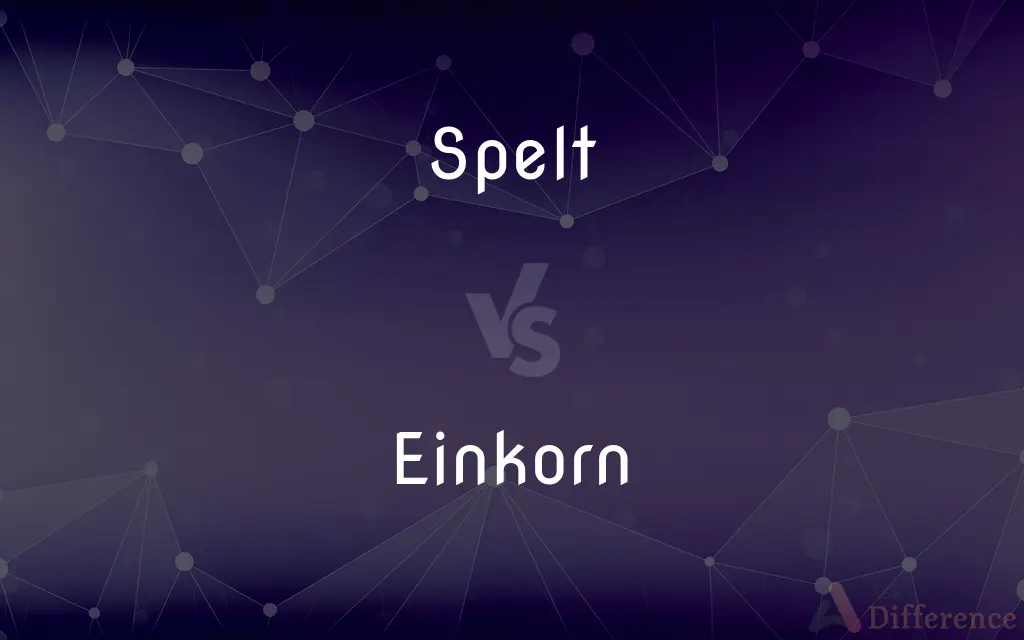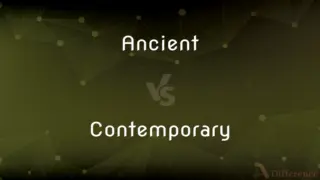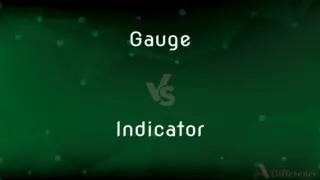Spelt vs. Einkorn — What's the Difference?
Edited by Tayyaba Rehman — By Urooj Arif — Updated on April 1, 2024
Spelt is a versatile ancient grain known for its nutty flavor, while Einkorn is the oldest wheat variety, prized for its nutritional benefits.

Difference Between Spelt and Einkorn
Table of Contents
ADVERTISEMENT
Key Differences
Spelt, an ancient grain, has been cultivated for thousands of years and is known for its slightly sweet, nutty flavor. It's a species of wheat that has gained popularity in recent times for its health benefits and versatility in cooking. Einkorn, on the other hand, is considered the oldest variety of wheat and is distinguished by its unique nutritional profile, including high levels of protein and antioxidants. It has a delicate, nutty taste that differs subtly from spelt.
Spelt flour is slightly higher in gluten than einkorn, making it more adaptable for baking bread and other baked goods that require rising. While spelt can be used similarly to modern wheat, it retains a distinctive taste and texture that enhances recipes. Einkorn flour, with its lower gluten content, offers a challenge for traditional baking but excels in dishes where its rich flavor can stand out, such as pancakes, crackers, and artisan breads.
Nutritionally, spelt offers a range of vitamins and minerals, including B vitamins, magnesium, and iron, contributing to a balanced diet. It is particularly noted for its dietary fiber content, which aids in digestion. Einkorn surpasses spelt in certain nutritional aspects, boasting higher levels of protein and lutein, an antioxidant that supports eye health, making it an excellent choice for those looking to boost their nutritional intake.
The adaptability of spelt extends to its cultivation, as it thrives in a variety of climates and soil types, making it accessible to a wide range of farmers. Its robust nature ensures a reliable harvest, even in less than ideal conditions. Einkorn, while also adaptable, is less commonly cultivated and requires more specific conditions to flourish, contributing to its status as a niche crop with a smaller production scale.
Despite their differences, both spelt and einkorn share a common appeal among those seeking alternatives to conventional wheat due to their ancient lineage, which is believed to offer health benefits linked to their less hybridized and modified genetic makeup. This appeal is part of a broader trend towards ancient grains and a return to traditional dietary staples.
ADVERTISEMENT
Comparison Chart
Origin
An ancient grain known for thousands of years.
The oldest wheat variety, cultivated for over 10,000 years.
Gluten Content
Higher than einkorn, suitable for many baking needs.
Lower, challenging for some traditional baking.
Nutritional Benefits
Rich in dietary fiber, B vitamins, magnesium, and iron.
Higher in protein and antioxidants like lutein.
Flavor
Nutty and slightly sweet.
Delicate, nutty, and distinct.
Agricultural Adaptability
Thrives in a variety of conditions, more widely cultivated.
Requires more specific conditions, less widely grown.
Compare with Definitions
Spelt
An ancient grain known for its nutty flavor and versatility in cooking.
She used spelt flour to make a rustic, nutty bread that was both delicious and nutritious.
Einkorn
Best used in dishes where its unique flavor can shine, like salads and artisan breads.
Einkorn flour made excellent pancakes with a rich, nutty flavor unlike any other wheat.
Spelt
Offers a good source of dietary fiber, vitamins, and minerals.
Adding spelt grains to your diet can boost your intake of B vitamins and magnesium.
Einkorn
The oldest wheat variety, known for its rich nutritional content and distinctive flavor.
Einkorn grains were found in ancient sites, showing it was cultivated by early farmers.
Spelt
Has seen a resurgence in popularity as part of the ancient grains trend.
Spelt products are now more widely available in health food stores, from bread to cereals.
Einkorn
High in protein and antioxidants, with a lower gluten content.
Einkorn is considered a superfood due to its high levels of lutein and protein.
Spelt
Adaptable to various growing conditions, making it popular among organic farmers.
The farmer decided to plant spelt this year because it's less demanding and more resistant to diseases.
Einkorn
Gaining interest among health-conscious consumers and those exploring ancient diets.
Finding einkorn in mainstream supermarkets is becoming easier as its popularity grows.
Spelt
Well-suited for baking due to its higher gluten content.
Spelt pasta has a unique flavor and texture, differentiating it from regular wheat pasta.
Einkorn
Less commonly grown, requiring specific conditions but offering a sustainable choice for small-scale farming.
He grows einkorn on a small plot of land, valuing its heritage and nutritional benefits.
Spelt
Spelt (Triticum spelta), also known as dinkel wheat or hulled wheat, is a species of wheat that has been cultivated since approximately 5,000 BC. Spelt was an important staple food in parts of Europe from the Bronze Age to medieval times. Now it survives as a relict crop in Central Europe and northern Spain, and it has found a new market as a health food.
Einkorn
A type of wheat (Triticum monococcum syn. T. monococcum subsp. monococcum) typically having one grain per spikelet, grown in semiarid regions. It was domesticated by Neolithic peoples in the Near East and is now cultivated in Europe and southwest Asia.
Spelt
An old kind of wheat with bearded ears and spikelets that each contain two narrow grains, not widely grown but favoured as a health food.
Einkorn
Einkorn wheat.
Spelt
A type of wheat (Triticum spelta syn. T. aestivum subsp. spelta) having a tough hull. It was widely cultivated in southwest Asia, the Near East, and Europe during the Bronze Age and is now grown chiefly in Europe.
Spelt
A past tense and a past participle of spell1.
Spelt
Simple past tense and past participle of spell
Spelt
(obsolete) To split; to break; to spalt.
Spelt
A grain, considered either a subspecies of wheat, Triticum aestivum subsp. spelta, or a separate species Triticum spelta or Triticum dicoccon.
Hulled wheat
Spelt
A thin piece of wood or metal; a splinter.
Spelt
(metalworking) Spelter.
Spelt
A species of grain (Triticum Spelta) much cultivated for food in Germany and Switzerland; - called also German wheat.
Spelt
Spelter.
Spelt
To split; to break; to spalt.
Spelt
Hardy wheat grown mostly in Europe for livestock feed
Common Curiosities
Can spelt and einkorn be used interchangeably in recipes?
Due to differences in gluten content and flavor, they may not be directly interchangeable in recipes without adjustments for texture and taste.
What are spelt and einkorn?
Spelt and einkorn are both ancient grains. Spelt is known for its versatility and nutty flavor, while einkorn is prized for its nutritional content and status as the oldest wheat variety.
Are spelt and einkorn gluten-free?
No, both spelt and einkorn contain gluten, although einkorn's gluten is different in composition and may be more tolerable for some people with sensitivities.
How does the taste of spelt compare to einkorn?
Spelt has a nutty and slightly sweet flavor, while einkorn offers a delicate, nutty taste that is uniquely its own.
Which is more nutritious, spelt or einkorn?
Einkorn generally has a higher protein and antioxidant content, including lutein, making it slightly more nutritious in certain aspects than spelt.
Is einkorn more expensive than spelt?
Einkorn can be more expensive than spelt due to its niche market, lower yield, and more specialized growing requirements.
How do spelt and einkorn contribute to sustainability?
Their adaptability and resilience make them suitable for organic farming practices, contributing to agricultural diversity and sustainability.
Can people with wheat allergies eat spelt or einkorn?
Individuals with wheat allergies or celiac disease should avoid spelt and einkorn, as they contain gluten.
Why are ancient grains like spelt and einkorn becoming popular?
They offer nutritional benefits, unique flavors, and are seen as healthier alternatives to modern hybridized wheat varieties.
What are the best uses for spelt and einkorn in the kitchen?
Spelt is excellent for baking bread and pasta due to its gluten content, whereas einkorn is ideal for dishes where its distinctive flavor can be appreciated, like salads and artisan breads.
Share Your Discovery

Previous Comparison
Ancient vs. Contemporary
Next Comparison
Gauge vs. IndicatorAuthor Spotlight
Written by
Urooj ArifUrooj is a skilled content writer at Ask Difference, known for her exceptional ability to simplify complex topics into engaging and informative content. With a passion for research and a flair for clear, concise writing, she consistently delivers articles that resonate with our diverse audience.
Edited by
Tayyaba RehmanTayyaba Rehman is a distinguished writer, currently serving as a primary contributor to askdifference.com. As a researcher in semantics and etymology, Tayyaba's passion for the complexity of languages and their distinctions has found a perfect home on the platform. Tayyaba delves into the intricacies of language, distinguishing between commonly confused words and phrases, thereby providing clarity for readers worldwide.














































